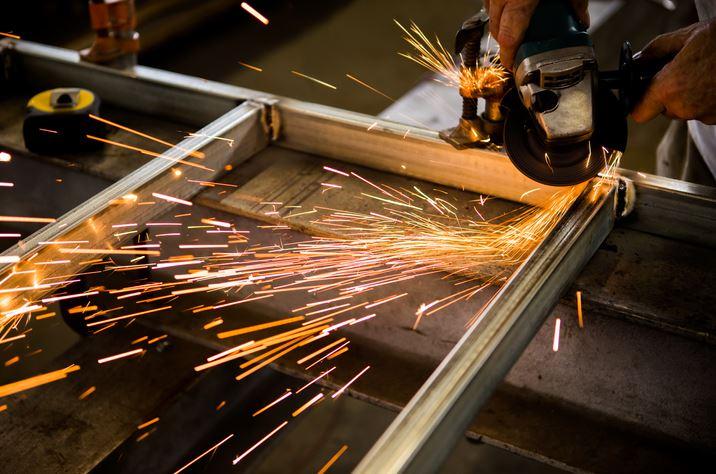Editor-in-Chief
- FMA
- The Fabricator
- FABTECH
- Canadian Metalworking
Categories
- Additive Manufacturing
- Aluminum Welding
- Arc Welding
- Assembly and Joining
- Automation and Robotics
- Bending and Forming
- Consumables
- Cutting and Weld Prep
- Electric Vehicles
- En Español
- Finishing
- Hydroforming
- Laser Cutting
- Laser Welding
- Machining
- Manufacturing Software
- Materials Handling
- Metals/Materials
- Oxyfuel Cutting
- Plasma Cutting
- Power Tools
- Punching and Other Holemaking
- Roll Forming
- Safety
- Sawing
- Shearing
- Shop Management
- Testing and Measuring
- Tube and Pipe Fabrication
- Tube and Pipe Production
- Waterjet Cutting
Industry Directory
Webcasts
Podcasts
FAB 40
Advertise
Subscribe
Account Login
Search
Avoiding metal dust explosions
A lack of awareness about the combustibility of metal dust increases the probability of injuries or even possible fatalities
- By Dan Davis
- April 3, 2023

The dust that results from grinding aluminum can be a danger. Does your shop manage it effectively to minimize the risk of injury?stevecoleimages/iStock/Getty Images Plus
No one has to remind metal fabricators of the dangers associated with the job. Sharp edges and heavy objects can be found all around the shop. But it might be the danger they don’t notice—metal dust—that poses one of the biggest risks to workers on the shop floor.
Metal dust explosions result from high concentrations of combustible dust particles rapidly combusting inside an enclosed space. Once ignited, oxygen in the atmosphere feeds the flame, and these fine particles ignite very quickly, creating the potential for an explosion if a lot of dust is present and no sprinkler system is triggered.
Those metal fabricators that have been around large pieces of aluminum with lit cigarettes in their mouths didn’t have much to worry about. On these large workpieces, a thin oxide layer hinders the diffusion of oxygen into the metal and prevents a chemical reaction that could cause damage. Aluminum dust resulting from activities such as surface finishing, however, doesn’t have that thin oxide covering all the dust particle surface layers. That dust, as a result, can heat up and burn very easily. When exposed to an ignition source, such as a cigarette ash or the spark from a motor, the dust has the potential to explode.
The metal dust is dangerous enough, but the lack of concern about the potential hazard might be even more dangerous.
On Oct. 29, 2003, Hayes Lemmerz International, an aluminum wheel manufacturing plant in Huntington, Ind., had a fire that was caused by the ignition of fine powdered aluminum in a dust collection system outside the building. The dust, a byproduct of aluminum scraps from the machining process, was being produced at an excessive rate by the chip drying system, and no one gave it much thought, even though the facility had a history of small dust fires.
On that fateful late fall evening, an explosion in the dust collector sent a pressure wave through the system ductwork and back into the building. According to a report from the U.S. Chemical Safety and Hazard Investigation Board, the pressure sent a fireball into the building, which lofted and ignited further aluminum that had accumulated on rafters and equipment.
Accidents do happen, but they should not occur because of lack of awareness. Metal fabricators interested in learning more about this can join a webinar by Camfil APC on June 14 at 1 p.m CDT.
This webinar will discuss the different types of airborne dusts; the issues associated with poor indoor air quality, combustible dusts, and toxic dusts; and the various metalworking applications that generate airborne dust. The presentation also will explain the available filtration options to ensure safety, while simultaneously improving indoor air quality.
To learn more, click here.
subscribe now

The Fabricator is North America's leading magazine for the metal forming and fabricating industry. The magazine delivers the news, technical articles, and case histories that enable fabricators to do their jobs more efficiently. The Fabricator has served the industry since 1970.
start your free subscriptionAbout the Author

Dan Davis
2135 Point Blvd.
Elgin, IL 60123
815-227-8281
Dan Davis is editor-in-chief of The Fabricator, the industry's most widely circulated metal fabricating magazine, and its sister publications, The Tube & Pipe Journal and The Welder. He has been with the publications since April 2002.
Related Companies
- Stay connected from anywhere

Easily access valuable industry resources now with full access to the digital edition of The Fabricator.

Easily access valuable industry resources now with full access to the digital edition of The Welder.

Easily access valuable industry resources now with full access to the digital edition of The Tube and Pipe Journal.
- Podcasting
- Podcast:
- The Fabricator Podcast
- Published:
- 04/16/2024
- Running Time:
- 63:29
In this episode of The Fabricator Podcast, Caleb Chamberlain, co-founder and CEO of OSH Cut, discusses his company’s...
- Trending Articles
Tips for creating sheet metal tubes with perforations

JM Steel triples capacity for solar energy projects at Pennsylvania facility

Are two heads better than one in fiber laser cutting?

Supporting the metal fabricating industry through FMA

Omco Solar opens second Alabama manufacturing facility

- Industry Events
16th Annual Safety Conference
- April 30 - May 1, 2024
- Elgin,
Pipe and Tube Conference
- May 21 - 22, 2024
- Omaha, NE
World-Class Roll Forming Workshop
- June 5 - 6, 2024
- Louisville, KY
Advanced Laser Application Workshop
- June 25 - 27, 2024
- Novi, MI


























